 设为首页
设为首页
 加入收藏
加入收藏
扩展资料

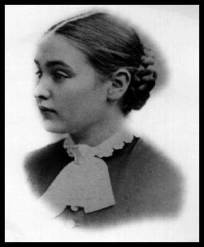 Annie Sullivan
was born April fourteenth, 1866, to
Irish parents. When she was nine years
old, Annie went to a town called Tewksbury
because her mother had died and the
rest of her family did not want to care
for her. Annie sometimes threw temper
tantrums. She had to live in the poorhouse.
While she was there, the illness that
had been in her eyes since she was three
caused her to become blind.
Annie Sullivan
was born April fourteenth, 1866, to
Irish parents. When she was nine years
old, Annie went to a town called Tewksbury
because her mother had died and the
rest of her family did not want to care
for her. Annie sometimes threw temper
tantrums. She had to live in the poorhouse.
While she was there, the illness that
had been in her eyes since she was three
caused her to become blind.
On the third of October, 1880, Annie moved to the Perkins Institution for the Blind, she was fourteen years old. Six years later, in 1886, Annie graduated from college. She made a speech and even got new shoes and a new dress to wear on this occasion.
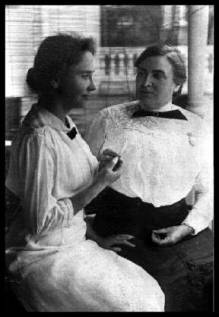 On March third, 1887, Annie Sullivan
met Helen Keller for the first time,
she was to be her governess. Helen Keller
had also become blind, but she was also
deaf and mute. Annie helped Helen talk,
read, write and feel things. Annie made
Helen happy and helped her to have a
good life.
On March third, 1887, Annie Sullivan
met Helen Keller for the first time,
she was to be her governess. Helen Keller
had also become blind, but she was also
deaf and mute. Annie helped Helen talk,
read, write and feel things. Annie made
Helen happy and helped her to have a
good life.
In 1900, Annie helped Helen get into college and Helen graduated in 1904.
On October nineteenth, 1936, Annie Sullivan passed away, leaving Helen Keller by herself.
Annie Sullivan is remembered for the good things she did for Helen Keller and her family.
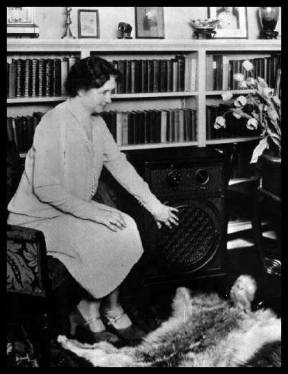
Helen Keller seated next to a radio, with her left hand on its speaker. A bookcase and a vase of flowers are in the background, and a rug made from the skin of an animal is in the foreground, at her feet. Circa 1927.
Helen Adams Keller was born on 27 June 1880 in Tuscumbia, a small rural town in Northwest Alabama, USA. The daughter of Captain Arthur Henley Keller and Kate Adams Keller she was born with full sight and hearing.
Kate Keller was a tall, statuesque blond with blue eyes. She was some twenty years younger than her husband Captain Keller, a loyal southerner who had proudly served in the Confederate Army during the American Civil War.
The house they lived in was a simple, white, clapboard house built in 1820 by Helen's grandparents. At the time of Helen's birth the family were far from wealthy with Captain Keller earning a living as both a cotton plantation owner and the editor of a weekly local newspaper, the "North Alabamian". Helen's mother, as well as working on the plantation, would save money by making her own butter, lard, bacon and ham.
But Helen's life was to change dramatically. In February 1882, when Helen was nineteen months old, she fell ill. To this day the nature of her ailment remains a mystery. The doctors of the time called it "brain fever", whilst modern day doctors think it may have been scarlet fever or meningitis.
Whatever the illness, Helen was, for many days, expected to die. When, eventually, the fever subsided, Helen's family rejoiced believing their daughter to be well again. However, Helen's mother soon noticed how her daughter was failing to respond when the dinner bell was rang or when she passed her hand in front of her daughter's eyes.
It thus became apparent that Helen's illness had left her both blind and deaf.
The following few years proved very hard for Helen and her family. Helen became a very difficult child, smashing dishes and lamps and terrorising the whole household with her screaming and temper tantrums. Relatives regarded her as a monster and thought she should be put into an institution.
By the time Helen was six her family had become desperate. Looking after Helen was proving too much for them. Kate Keller had read in Charles Dickens' book "American Notes" of the fantastic work that had been done with another deaf and blind child, Laura Bridgman, and travelled to a specialist doctor in Baltimore for advice. They were given confirmation that Helen would never see or hear again but were told not to give up hope, the doctor believed Helen could be taught and he advised them to visit a local expert on the problems of deaf children. This expert was Alexander Graham Bell, the inventor of the telephone, Bell was now concentrating on what he considered his true vocation, the teaching of deaf children.
Alexander Graham Bell suggested that the Kellers write to Michael Anagnos, director of the Perkins Institution and Massachusetts Asylum for the Blind, and request that he try and find a teacher for Helen. Michael Anagnos considered Helen's case and immediately recommended a former pupil of the institution, that woman was Anne Sullivan.
Anne Sullivan had lost the majority of her sight at the age of five. By the age of ten, her mother had died and her father deserted her. She and her brother Jimmie were sent to the poorhouse in February 1876.
Anne's brother died in the poorhouse. It was October 1880 before Anne finally left and went to commence her education at the Perkins Institution. One summer during her time at the institute, Anne had two operations on her eyes, which led to her regaining enough sight to be able to read normal print for short periods of time.
Anne graduated from Perkins in 1886 and began to search for work. Finding work was terribly difficult for Anne, due to her poor eyesight, and when she received the offer from Michael Anagnos to work as the teacher of Helen Keller, a deaf-blind mute, although she had no experience in this area, she accepted willingly.
On 3 March 1887 Anne arrived at the house in Tuscumbia and for the first time met Helen Keller. Anne immediately started teaching Helen to finger spell. Spelling out the word "Doll" to signify a present she had brought with her for Helen. The next word she taught Helen was "Cake". Although Helen could repeat these finger movements she could not quite understand what they meant. And while Anne was struggling trying to help her understand, she was also struggling to try and control Helen's continuing bad behaviour.
Anne and Helen moved into a small cottage on the land of the main house to try and get Helen to improve her behaviour. Of particular concern were Helen's table manners. She had taken to eating with her hands and from the plates of everyone at the table.
Anne's
attempts to improve Helen's table manners
and make her brush her own hair and
button her shoes led to more and more
temper tantrums. Anne punished these
tantrums by refusing to "talk"
with Helen by spelling words on her
hands.
Over the coming weeks, however, Helen's
behaviour did begin to improve as a
bond grew between the two. Then, after
a month of Anne's teaching, what the
people of the time called a "miracle"
occurred.
Helen had until now not yet fully understood the meaning of words. When Anne led her to the water pump on 5 April 1887, all that was about to change.
As Anne pumped the water over Helen's hand , Anne spelled out the word water in the girl's free hand. Something about this explained the meaning of words within Helen, and Anne could immediately see in her face that she finally understood.
Helen later recounted the incident:
"We walked down the path to the well-house, attracted by the fragrance of the honey-suckle with which it was covered. Someone was drawing water and my teacher placed my hand under the spout. As the cool stream gushed over one hand she spelled into the other the word water, first slowly, then rapidly. I stood still, my whole attention fixed upon the motions of her fingers. Suddenly I felt a misty consciousness as of something forgotten, a thrill of returning thought, and somehow the mystery of language was revealed to me."
Helen immediately asked Anne for the name of the pump to be spelt on her hand and then the name of the trellis. All the way back to the house Helen learned the name of everything she touched and also asked for Anne's name. Anne spelled the name "Teacher" on Helen's hand. Within the next few hours Helen learnt the spelling of thirty new words.
Helen's progress from then on was astonishing. Her ability to learn was far in advance of anything that anybody had seen before in someone without sight or hearing. It wasn't long before Anne was teaching Helen to read, firstly with raised letters and later with braille, and to write with both ordinary and braille typewriters.
Michael Anagnos was keen to promote Helen, one of the numerous articles on her that he wrote said of Helen that "she is a phenomenon". These articles led to a wave of publicity about Helen with pictures of her reading Shakespeare or stroking her dog appearing in national newspapers.
Helen had become famous, and as well as again visiting Alexander Graham Bell, she visited President Cleveland at the White House. By 1890 she was living at the Perkins Institute and being taught by Anne. In March of that year Helen met Mary Swift Lamson who over the coming year was to try and teach Helen to speak. This was something that Helen desperately wanted and although she learned to understand what somebody else was saying by touching their lips and throat, her efforts to speak herself proved at this stage to be unsuccessful. This was later attributed to the fact that Helen's vocal chords were not properly trained prior to her being taught to speak.
In Helen's own words:
"The public must learn that the blind man is neither genius nor a freak nor an idiot. He has a mind that can be educated, a hand which can be trained, ambitions which it is right for him to strive to realise, and it is the duty of the public to help him make the best of himself so that he can win light through work."
Helen and Anne filled the following years with lecture tours, speaking of her experiences and beliefs to enthralled crowds. Her talks were interpreted sentence by sentence by Anne Sullivan, and were followed by question and answer sessions.
Although Helen and Anne made a good living from their lectures, by 1918 the demand for Helen's lectures had diminished and they were touring with a more light-hearted vaudeville show, which demonstrated Helen's first understanding of the word "water". These shows were hugely successful from the very first performance, a review of which read as follows:
"Helen Keller has conquered again, and the Monday afternoon audience at the Palace, one of the most critical and cynical in the World, was hers."
At this time they were also offered the chance to make a film in Hollywood and they jumped at the opportunity. "Deliverance", the story of Helen's life, was made. Helen was, however, unhappy with the glamorous nature of the film and it unfortunately did not prove to be the financial success that they had hoped for.
The vaudeville appearances continued with Helen answering a wide range of questions on her life and her politics and Anne translating Helen's answers for the enthralled audience. They were earning up to two thousand dollars a week, which was a considerable sum of money at the time.
In 1918 Helen, Anne and John moved to Forest Hills in New York. Helen used their new home as a base for her extensive fundraising tours for the American Foundation for the Blind. She not only collected money, but also campaigned tirelessly to alleviate the living and working conditions of blind people, who at that time were usually badly educated and living in asylums. Her endeavours were a major factor in changing these conditions.
Helen's mother Kate died in 1921 from an unknown illness, and this left Anne as the sole constant in Helen's life. However that same year Anne fell ill again and this was followed in 1922 by a severe bout of bronchitis which left her unable to speak above a whisper and thus unable to work with Helen on stage anymore. At this point Polly Thomson, who had started working for Helen and Anne in 1914 as a secretary, took on the role of explaining Helen to the theatre going public.
They also spent a lot of time touring the world raising money for blind people. In 1931 they met King George and Queen Mary at Buckingham Palace, who were said to be deeply impressed by Helen's ability to understand what people said through touch.
All the while Anne's health was getting worse, and with the news of the death of John Macy in 1932, although their marriage had broken up some years before, her spirit was finally broken. She died on 20 October 1936.
When Anne died, Helen and Polly moved to Arcan Ridge, in Westport, Connecticut, which would be Helen's home for the rest of her life.
After World War Two, Helen and Polly spent years travelling the world fundraising for the American Foundation for the Overseas Blind. They visited Japan, Australia, South America, Europe and Africa.
Whilst away during this time Helen and Polly learnt of the fire that destroyed their home at Arcan Ridge. Although the house would be rebuilt, as well as the many mementoes that Helen and Polly lost, also destroyed was the latest book that Helen had been working on about Anne Sullivan, called "Teacher".
It was also during this time that Polly Thomson's health began to deteriorate and whilst in Japan she had a mild stroke. Doctors advised Polly to stop the continuous touring she and Helen did, and although initially they slowed down a bit, the touring continued once Polly had recovered.
In 1953 a documentary film "The Unconquered" was made about Helen's life, this was to win an Academy Award as the best feature length documentary .It was at the same time that Helen began work again on her book "Teacher", some seven years after the original had been destroyed. The book was finally published in 1955.
Polly Thomson had a stroke in 1957, she was never to fully recover and died on March 21, 1960. Her ashes were deposited at the National Cathedral in Washington DC next to those of Anne Sullivan. It was the nurse who had been brought in to care for Polly in her last years, Winnie Corbally, who was to take care of Helen in her remaining years.
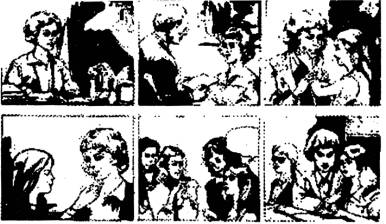
4)导入技巧结束后,教师开始讲课。
二、
结束技巧在记叙文体中的运用
在结束技巧中指出:
结束环节能进一步安排学生的活动(练习,提问,小结,讨论。);结束环节有利于巩固所学知识,激发学生学习兴趣。
我们应当高度重视结束技巧因为这是教师依据课堂教学设计,在完成一定的教学内容或活动后,通过重复强调、归纳总结,使学生对所学的知识形成完整的认知结构并转化为能力的方式。
此节课为了更好地巩固所学到的知识,教师可以布置作业,并进一步安排一些学生活动,借以拓宽、延伸教学内容,激发学生浓厚的学习兴趣,这对提高课堂教学效率将产生重要的作用。课堂教学结束的语言少而精,点明重点,首尾呼应,同时进一步设疑激趣,应给同学有思考的空间,培养学生的语言能力及创造性思维。
作业:
l)提问学生:什么叫记叙文?记叙文一般包括哪些内容?
(答)记叙文主要叙述所发生的事情或经历。记叙文一般按时间顺序对事件进行叙述。常见的形式有:日记、传记名传、故事、游记等。
2)根据课文作英语写一篇100字左右的读后感。或Helen Keller的自传。
(教师给参考答案)
Helen Adams Keller (1880-1968)was a U. S. writer. At the age of 19 months, she was deprived by illness of sight and hearing and soon became mute. Annie Mansfield Sullivan then 20 years old, began to teach Helen when she was about seven years old. Miss Sullivan, formerly blind but partially cured of blindness, was a graduate of the Perkins School for the Blind at Boston, Mas-sachusette. About a month after her arrival , she imparted the gift of language to her pupil. Under Miss Sullivans constant teaching and with instruction at the Horace Mann School for the Deaf, and the Wright - Humason Oral School, Helen Keller not only learned to read, write and talk , but became exceptionally proficient in the ordinary educational curriculum. In 1900 she entered Radcliffe College , from which she graduated as a teacher was almost as marvelous as the talent of her pupil , was a devoted companion until her death in 1936.
Helen Keller wrote many books and articles. The most important of these were The Story of My Life ( 1902) , from which the text of this lesson has been taken, Optimism ( 1903) ) The World I live In (1908), Helen Kellere Journal (1938), Let Us Have Faith (1940) and so on.
扩展资料
微格教学导入技巧在英语记叙文中的作用
My Teacher
(Senior English Bk. 3 Unit 17, Lesson 66)
关于微格教学导入技巧及结束技巧在英语记叙文中的运用我们在上节课中谈到Micro-teaching在英语说明文(expository essay)中的运用。今天我们继续谈谈(Micro- teaching)在英语记叙文(narrative essay)中的作用。
先谈谈导入技巧和结束技巧在记叙文体中的作用。Micro-teaching在导入技巧的第一条中强调导入课文时要能引起学生学习兴趣和学习积极性。笔者认为激发兴趣的目的是为学生学好新课创造良好的前提,从而全方位提高自己的听、说、读、写能力。激发学生学习兴趣,方法很多。我们上节课使用的是图片和现代化教学手段(如大屏幕、投影仪等设备)相结合的方法。另外,我们还可发通过讲故事、讲新闻、巧设悬念、提出导性问题等等来引起同学们的兴趣。所谓兴趣就是指一个人对某件事情的喜好程度,有了喜好才会投入。
本节课unit 17 “My Teacher”是一篇记叙文体。我认为用讲故事的方法给同学们讲故事更能引起他(她)们的学习积极性,而且这样做也适合学生的年龄特点和心理特征。中小学生都喜欢听故事,所以我们应当充分利用学生这一特点来展开课文。下面我们开始讲 Helen Keller这是一个与正式课文My Teacher有紧密联系的动人的故事,是关于一个杰出的盲人教师最后经过坚忍不拔的学习毅力而成才的故事。故事扣人心弦,给在世人们留下了终生难忘的启迪、回忆、思考。教师那颗爱心和崇高的思想境界使我们所有师生的思想在潜移默化中得到了进一步的升华。
下面谈谈具体做法:
l)教师开始讲故事,开始讲之前先展示一张图片并进行导入性提问:
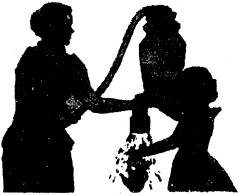
教师问:What is this picture about? Is it the mother who is helping her child to wash her hands ?
(答:No, it is Annie Sullivan who is helping Helen Keller to spell the word W-a-t-e-r)
下面教师就开始讲这动人的故事……
Helen Keller
The most important day I remember in all my life is the one on which my teacher, Annie Mansfield Sullivan, came to me. I am filled with wonder when I consider the big difference between the two lives which it connects. It was the third of March, 1887, three months before I was seven years old, wrote Helen Keller.
The morning after the arrival of her teacher. Helen was led into a room and given a doll. After she had played with it for a while, Miss Sullivan slowly spelt the word d-o-l-l onto her hand. At once Helen was interested in this finger play and tried to imitate her teacher. When she finally succeeded in forming the letters correctly, she was filled with pleasure and pride. And in the days that followed, she learned to spell a great many words in this way, among which were hat, cup and a few verbs like sit, stand and walk. But her teacher had been with her several weeks before she understood that things and actions had names.
Once, as we were walking down the road to the well, I was attracted by some strange smell in the air. I asked. What is that strange smell in the air? Miss Sullivan led me to the well. Someone was drawing water. She took my hand and placed it under the flowing water, As the cool water washed Helens hand Miss Sullivan spelt the word water on her other hand, first slowly, then quickly. Helen stood still. She knew then that w-a-t-e-r means the cool liquid she was now playing with both her hands. That living word gave her joy, light and hope. She did not remember what they all were; but she knew that mother, father, sister, teacher were among them-words that were to make the word bright for her. As her education progressed, Helen was living a new life full of excitement. She now had the key to a language and was keen to use it.
We who have eyes to see and ears to hear can learn easily. But Helen could not as she was both blind and deaf. She did not allow herself to be handicapped. She made full use of all the other faculties she had to such an advantage that she became a world famous teacher of the blind.
根据Micro – teaching语言技巧一项给教师提出的要求是:
讲解课文或讲故事:
吐字要清楚,声音宏亮
速度节奏恰当
语言通顺连贯
语调起伏无语病
语感好,有激励性
2)为提高同学们的阅读理解我们先进行pre-reading.
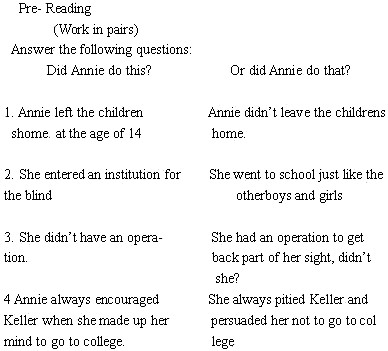
![]()
3)请同学们翻到Lesson 66, P. 28 STORY TELLING让学生根据课文中的六幅图片,自己用英语来讲故事。可进行比赛,看谁讲的好,借以激发他们的学习积极性,进一步提高学生的口语水平。